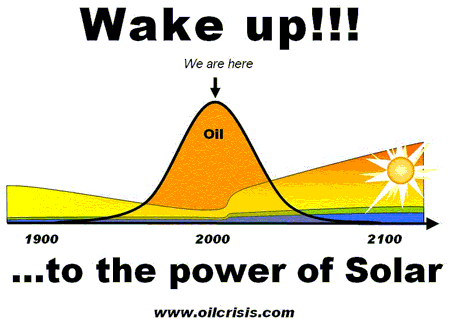Well actually it doesn’t. But it will definitely change our lifestyles and our foodchain. But not really the way either the right or the left think or at least want you to believe. Believe me I am not being callous when I simply say that lots of people will die. There is no denying that and if we let it CHAOS could insue. But I don’t it will happen that way. One way or another we will either very quickly get a lot more renewable energy sources in place or we as a nation will be forced to return to a small farm society. The Saudi’s know for sure what is coming because they just anounced another huge solar project. Something like this:
http://query.nytimes.com/gst/fullpage.html?sec=health&res=9D07E1D71639F932A35752C1A965948260
TWO years ago, this village of 3,000 people, only 20 miles from Riyadh, the capital of this kingdom, had no electricity. Today, villagers proudly display their televisions, toasters and other accouterments of an electrified society.
But when Saudis here turn their lights on at night, they are using energy generated not by their country’s vast oil reserves, but by the sun.
This village and two others nearby are the first in the kingdom, or anywhere, to be powered continuously and primarily by solar power.
:}
:}
I realize that yesterday I gave sort of a short shift to the Peak Oil people. I kinda acted like everyone in the audience would know what that is. So here are some of their more promenant sites:
Energy Sites
- The Coming Global Oil Crisis
- Die Off
- Dry Dipstick
- Energy Bulletin
- From the Wilderness
- Life After the Oil Crash
- Peak Oil Crisis
- Peak Oil News and Message Boards
- Powerswitch
- Rigzone
- Matthew Simmons
- Wolf at the Door
:}
Please note the bell shaped curve above. That is their arguement in a nutshell. In other words demand has exceeded the ability of the oil producers to provide oil. That ability to produce will eventually “fall off” as the supply ends and prices will go through the roof (read: become prohibitive). So what does that mean for the now Industrialized Foodchain?
In Michael Pollan’s 2006 book, The Omnivore’s Dilemma, he lays out huge problems with our corporate food chain:
http://en.wikipedia.org/wiki/The_Omnivore’s_Dilemma
Industrial
Pollan begins with an exploration of the food-production system from which the vast majority of American meals are derived. This industrial food chain is largely based on corn, whether it is eaten directly, fed to livestock, or processed into chemicals such as glucose and ethanol. Pollan discusses how the humble corn plant came to dominate the American diet through a combination of biological, cultural, and political factors. The role of petroleum in the cultivation and transportation of the American food supply is also discussed.
A fast food meal is used to illustrate the end result of the industrial food chain.
:}
In fact a scientist said that if humanity quit using nitrogen fertilizer it would be like taking EVERY automobile in the WORLD off the road.
However its interesting that he actually fails in what he sets out to do. His goal was actually to grow throught the progression of Industrial—> Small Farm—> Vegan—>Make my own meal. He wanted to make the point that Vegatarion was the way to go to save the planet from us humans. His thought being that he would make up a giant tofu salad at the end of the book. It did not go that way, because he quickly discovered that going meatless is tougher than he thought AND that it would take MORE energy inputs than we currently use to take the whole USA vegatarian. In other words we omnivores by DESIGN (duh) and we can’t change that by wishing it to be so. In the end he makes his meal and includes fish in it to show that heh you can “eat locally”. Hunting animals is a lot tougher than fishing. But heh he does not say how long it took to catch the one he shared.
Next – On to King Corn.
:}

